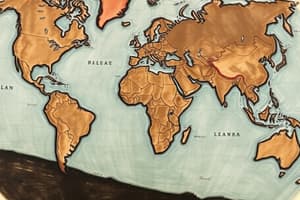Podcast
Questions and Answers
Immigration is the act of leaving one's home country.
Immigration is the act of leaving one's home country.
False (B)
Natural disasters are a push factor that drives people to migrate.
Natural disasters are a push factor that drives people to migrate.
True (A)
The Great Migration involved over 50 million people leaving Europe.
The Great Migration involved over 50 million people leaving Europe.
True (A)
One major reason people migrate today is the desire to learn new languages.
One major reason people migrate today is the desire to learn new languages.
Push factors drive individuals towards a new location.
Push factors drive individuals towards a new location.
Migrants from Asia have primarily settled in Antarctica.
Migrants from Asia have primarily settled in Antarctica.
The current percentage of the world's population that are migrants is more than 10%.
The current percentage of the world's population that are migrants is more than 10%.
Brain drain negatively impacts home countries by creating a shortage of skilled professionals.
Brain drain negatively impacts home countries by creating a shortage of skilled professionals.
Only developed countries benefit from skilled migration.
Only developed countries benefit from skilled migration.
The flow of knowledge ceases when skilled workers leave their home country.
The flow of knowledge ceases when skilled workers leave their home country.
Economic reasons are the primary motive behind migration when people are attracted to job opportunities.
Economic reasons are the primary motive behind migration when people are attracted to job opportunities.
Religious persecution is a push factor related to social reasons for migration.
Religious persecution is a push factor related to social reasons for migration.
Intraregional migration is defined as migration that occurs within the same continent.
Intraregional migration is defined as migration that occurs within the same continent.
Refugees fleeing a war-torn country is considered an example of forced migration.
Refugees fleeing a war-torn country is considered an example of forced migration.
Urban-rural migration involves individuals moving from urban areas to rural areas.
Urban-rural migration involves individuals moving from urban areas to rural areas.
Increased contribution to tax revenue is a positive economic impact of migration.
Increased contribution to tax revenue is a positive economic impact of migration.
Increased cultural diversity is considered a negative impact of migration on the destination country.
Increased cultural diversity is considered a negative impact of migration on the destination country.
Seasonal migration refers to voluntary permanent relocation.
Seasonal migration refers to voluntary permanent relocation.
Cultural exchange is a positive social impact of migration on the source country.
Cultural exchange is a positive social impact of migration on the source country.
Brain drain refers to the emigration of skilled workers to developed countries.
Brain drain refers to the emigration of skilled workers to developed countries.
Poor wages and working conditions act as a pull factor contributing to brain drain.
Poor wages and working conditions act as a pull factor contributing to brain drain.
Migration negatively affects the environment because it can increase pollution.
Migration negatively affects the environment because it can increase pollution.
Flashcards are hidden until you start studying
Study Notes
Migration Basics
- Immigration vs. Emigration: Immigration is the act of entering a new country to live, while emigration involves leaving one's home country.
- Push Factors: Primarily include natural disasters and conflicts that compel individuals to leave their homes.
- Pull Factors: Factors like better employment opportunities and improved standards of living attract individuals to new destinations.
Historical Context
- Great Migration: Over 50 million people left Europe between the late 19th and early 20th centuries for various reasons, primarily economic.
- Current Migration Trends: Today, the global migrant population is approximately 3% to 5% of the world's total population, marking a historic high.
Impact of Migration
- Positive Effects on Home Countries: Migration can lead to increased remittances, contributing positively to the economies of the migrants' home nations.
- Negative Effects - Brain Drain: Loss of skilled professionals can create shortages in essential services and slow down local economic growth.
- Destination Countries: Migration can introduce cultural diversity but may also lead to increased crime rates in certain contexts.
Migration Types
- Forced Migration: Involuntary movement due to factors like war, exemplified by refugees fleeing conflict zones.
- Rural to Urban Migration: Individuals often move from rural areas to cities seeking better job opportunities and living conditions.
- Seasonal Migration: Involves temporary movements for work based on seasonal demands.
Economic and Demographic Effects
- Economic Contributions: Migrants often boost the tax base of destination countries, increasing public revenue.
- Demographic Changes: Immigration can alter the age structure of the population, potentially leading to a skewed sex ratio or pressures on local services.
Challenges of Brain Drain
- Skill Loss: The migration of skilled individuals typically results in a lack of qualified personnel which impedes development in source countries.
- Push Factors for Brain Drain: Poor wages and inadequate working conditions in home countries drive educated individuals to seek opportunities abroad.
Environmental Considerations
- Environmental Impact: Increased migration can exacerbate pollution due to transportation and construction demands at destination locations.
Social Dynamics
- Cultural Exchange: Increased migration facilitates greater cultural exchanges and can enrich the social fabric of destination countries.
- Challenges of Integration: Societal resistance to new ideas can occur, leading to increased cultural conflicts or tensions.
Key Definitions
- Impelled Migration: A decision to leave based on unfavorable conditions rather than direct force.
- Intraregional Migration: Movement occurring within the same continent or region, distinct from international migration.
Notable Statistics
- Skilled Migration: The emigration of professionals to developed countries can lead to significant knowledge loss in the originating regions.
Studying That Suits You
Use AI to generate personalized quizzes and flashcards to suit your learning preferences.




